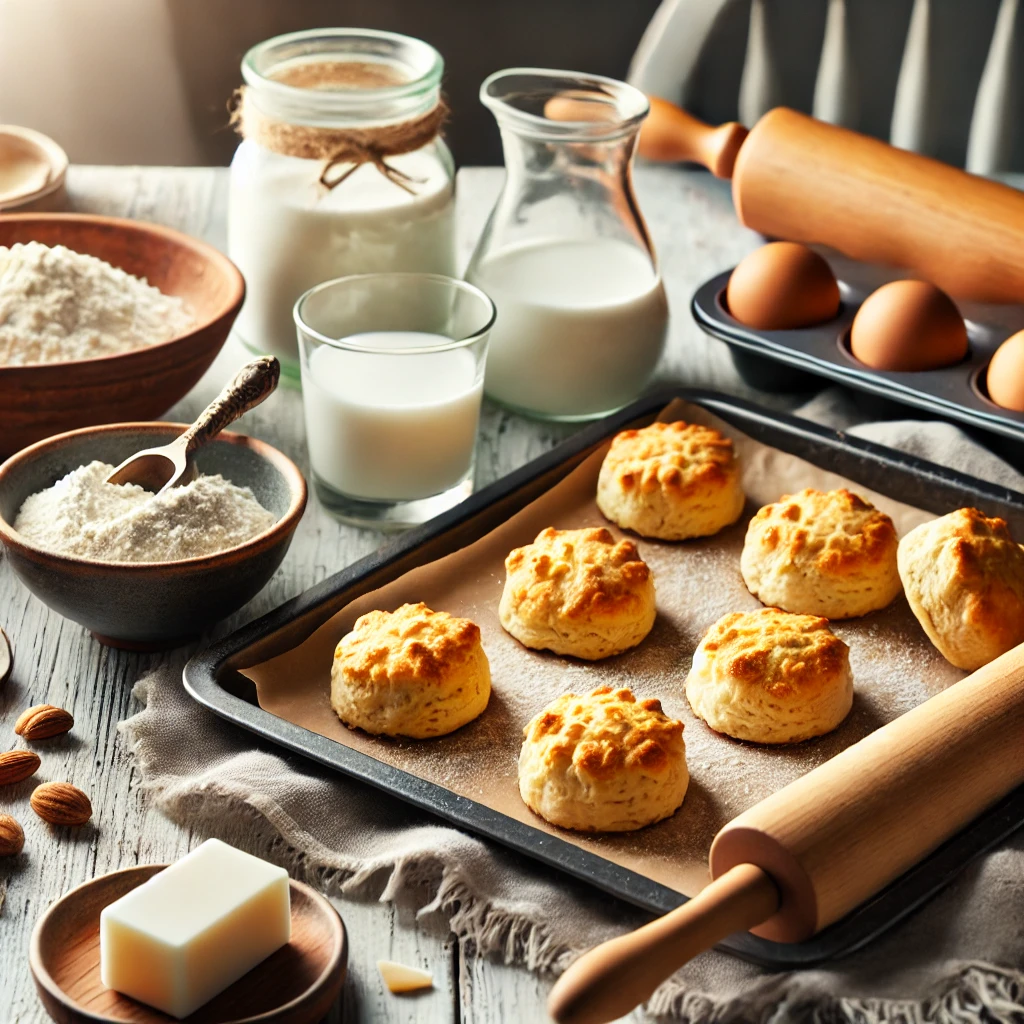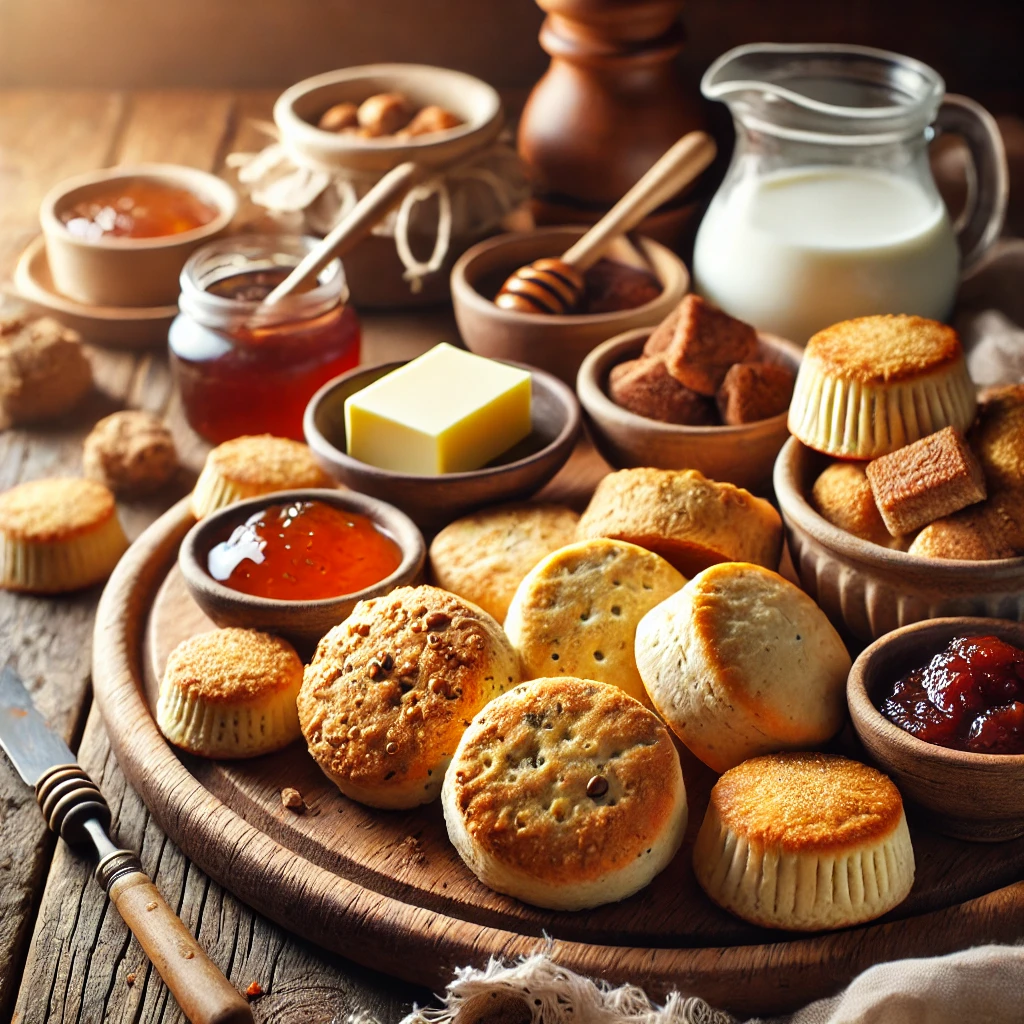When it comes to biscuits, many recipes and store-bought options contain milk or dairy ingredients like butter, buttermilk, or cream. However, there are plenty of milk-free biscuits available for those who are lactose-intolerant, vegan, or simply looking for dairy-free alternatives. In this article, we’ll explore the world of milk-free biscuits, including homemade recipes, store-bought options, and tips for identifying truly dairy-free choices.
Table of Contents
ToggleWhy Choose Biscuits Without Milk?
Milk-free biscuits cater to a variety of dietary needs and preferences:
- Lactose Intolerance: Many people are unable to digest lactose, the sugar found in milk.
- Vegan Lifestyle: Dairy-free biscuits align with plant-based diets.
- Allergies: Avoiding milk helps those with dairy allergies enjoy safe, delicious baked goods.
- Health Reasons: Cutting out milk can reduce fat and calories in some recipes.
Regardless of your reason, there are plenty of delicious options to satisfy your biscuit cravings without dairy.
What Are Milk-Free Biscuits?
Milk-free biscuits are those made without any form of milk or dairy ingredients. This includes not only fresh milk but also derivatives like butter, cream, and milk powder.
Key characteristics of milk-free biscuits:
- Moisture Source: Instead of milk, water, plant-based milk, or broth is used.
- Flavor: The lack of dairy doesn’t mean a lack of flavor—other ingredients like spices, herbs, and oils can enhance the taste.
- Texture: Depending on the recipe, milk-free biscuits can be soft, flaky, or crisp.
Homemade Milk-Free Biscuit Recipes

1. Classic Water Biscuits
A simple, no-milk recipe that uses water instead of milk for moisture.
Ingredients:
- 2 cups all-purpose flour
- 1 tablespoon baking powder
- 1/2 teaspoon salt
- 1/2 cup cold butter or plant-based margarine
- 2/3 cup ice-cold water
Instructions:
- Mix dry ingredients, cut in butter, and add water until a dough forms.
- Shape, cut, and bake at 425°F (220°C) for 12-15 minutes.
2. Vegan Coconut Milk Biscuits
Coconut milk adds a creamy texture without dairy.
Ingredients:
- 2 cups all-purpose flour
- 1 tablespoon baking powder
- 1/2 teaspoon salt
- 1/2 cup cold coconut oil
- 3/4 cup canned coconut milk
Instructions:
- Combine dry ingredients, cut in coconut oil, and mix in coconut milk.
- Shape, cut, and bake at 400°F (200°C) for 12-14 minutes.
3. Savory Herb Biscuits
A dairy-free biscuit infused with olive oil and herbs.
Ingredients:
- 2 cups all-purpose flour
- 1 tablespoon baking powder
- 1/2 teaspoon salt
- 1/4 cup olive oil
- 2/3 cup water
- 1 teaspoon dried herbs (e.g., rosemary, thyme)
Instructions:
- Combine dry ingredients, stir in olive oil and water, and mix until a dough forms.
- Shape, cut, and bake at 425°F (220°C) for 10-12 minutes.
Popular Store-Bought Milk-Free Biscuits
Many brands offer milk-free biscuits, making it easier to find options that fit your dietary needs. Here are some popular examples:
1. Digestive Biscuits
Many plain digestive biscuits are free from milk, though it’s important to check the label for hidden dairy ingredients.
2. Animal Crackers
Simple and lightly sweet, most animal crackers are dairy-free.
3. Graham Crackers
Some varieties of graham crackers are made without milk, but always confirm the ingredient list.
4. Store-Bought Vegan Biscuits
Brands like Annie’s, Trader Joe’s, and Nature’s Bakery often carry vegan or dairy-free biscuit options.
How to Identify Dairy-Free Biscuits
When shopping for biscuits, use these tips to identify milk-free options:
- Read Labels Carefully
- Look for terms like “contains milk” or “may contain traces of milk.”
- Avoid ingredients like whey, casein, or lactose.
- Look for Vegan Labels
- Products labeled as vegan are guaranteed to be free from milk and other animal-derived ingredients.
- Check Allergy Warnings
- Many products specify whether they are safe for those with dairy allergies.
- Choose Simple Recipes
- Biscuits with minimal ingredients are more likely to be dairy-free.
FAQs About Milk-Free Biscuits
1. Are biscuits without milk still fluffy?
Yes! The right techniques and substitutions like water, plant-based milk, or coconut milk can create fluffy, tender biscuits.
2. Can I use almond milk in biscuits?
Absolutely! Almond milk is a great substitute for milk in biscuit recipes, offering a mild nutty flavor.
3. Are there gluten-free and milk-free biscuits?
Yes, many gluten-free biscuits are also dairy-free. Look for certified gluten-free and vegan options.
4. What can I use instead of butter in biscuits?
You can use plant-based margarine, coconut oil, or olive oil instead of butter.
5. Do milk-free biscuits taste the same?
While the flavor may differ slightly, milk-free biscuits can be just as delicious with the right substitutions and seasonings.
6. Can I freeze milk-free biscuits?
Yes, milk-free biscuits freeze well. Store them in an airtight container and reheat before serving.
7. Are Oreos milk-free?
Yes, Oreos are dairy-free, but double-check ingredients in flavored varieties as some may contain milk derivatives.
8. Is baking with water instead of milk common?
Yes, many biscuit recipes successfully use water as a substitute, especially in savory variations.
9. What’s the best oil for milk-free biscuits?
Neutral oils like vegetable, canola, or olive oil work well in milk-free biscuit recipes.
10. Can I add flavors to milk-free biscuits?
Absolutely! Add herbs, spices, or sweeteners like sugar or maple syrup to customize your milk-free biscuits.
Conclusion
Finding or making biscuits without milk is easier than ever. From simple water-based recipes to store-bought vegan options, there’s a wide range of dairy-free biscuits to explore. Whether you’re managing dietary restrictions or simply experimenting with new recipes, milk-free biscuits offer a delicious and versatile solution. So, grab your ingredients and enjoy the satisfaction of homemade or store-bought biscuits without the dairy!
Milk-Free Biscuits for Every Occasion

Whether you’re looking for a savory accompaniment to soup or a sweet treat for dessert, milk-free biscuits fit perfectly into every meal. Here’s how to enjoy them in various settings:
1. Milk-Free Breakfast Biscuits
- Pairing Ideas:
- Serve warm biscuits with vegan butter, jam, or honey.
- Use biscuits as the base for breakfast sandwiches with plant-based sausage or scrambled tofu.
- Recipe Variation: Add cinnamon or vanilla to the dough for a sweet morning treat.
2. Savory Biscuits for Lunch or Dinner
- Pairing Ideas:
- Complement hearty soups, stews, or chili with flaky milk-free biscuits.
- Serve as a side dish for roasted vegetables or grilled plant-based proteins.
- Recipe Variation: Stir in shredded dairy-free cheese or fresh herbs like dill, parsley, or chives.
3. Milk-Free Desserts
- Pairing Ideas:
- Top milk-free biscuits with dairy-free whipped cream and fresh fruit for a delicious shortcake.
- Drizzle with dairy-free chocolate or caramel sauce for a decadent dessert.
- Recipe Variation: Sweeten the dough with a touch of sugar and a pinch of cinnamon.
The Role of Milk in Traditional Biscuits
To understand why milk-free alternatives work, it’s helpful to know what milk typically does in a biscuit recipe:
- Adds Moisture: Milk hydrates the flour, creating a cohesive dough.
- Contributes Fat: The natural fats in milk help enrich the texture and flavor.
- Promotes Browning: Milk sugars caramelize during baking, giving biscuits a golden crust.
When removing milk, it’s essential to replace these functions with alternatives like water, plant-based milk, or oils.
Milk-Free Substitutions for Biscuit Recipes
Here are some excellent substitutes for milk in biscuits, each bringing unique qualities to the recipe:
1. Water
- Benefits: Readily available and neutral in flavor.
- Best For: Savory biscuits where richness isn’t the focus.
- Tip: Add a bit more fat (like butter or oil) to compensate for milk’s richness.
2. Plant-Based Milk
- Options: Almond, soy, oat, rice, or coconut milk.
- Benefits: Adds creaminess without dairy.
- Best For: Sweet or mildly flavored biscuits.
- Tip: Use unsweetened varieties to avoid altering the recipe’s flavor.
3. Coconut Milk
- Benefits: Rich and creamy, with a subtle coconut flavor.
- Best For: Sweet biscuits or tropical-inspired variations.
- Tip: Use full-fat coconut milk for the best texture.
4. Broth
- Benefits: Adds savory depth.
- Best For: Herb-infused or savory biscuits.
- Tip: Vegetable broth works well for vegan recipes.
Store-Bought Milk-Free Biscuit Brands to Try
Several brands offer milk-free biscuits that cater to dietary needs without sacrificing flavor:
1. Annie’s Organic Biscuits
- Vegan and made with plant-based ingredients.
2. Pillsbury Crescent Rolls
- Many varieties are dairy-free and versatile for savory or sweet dishes.
3. Nature’s Bakery Fig Bars
- A soft and chewy option for those seeking a sweet, milk-free treat.
4. Trader Joe’s Biscuits
- Check their frozen and packaged biscuit options, as several are vegan and milk-free.
5. Simple Mills Almond Flour Biscuits
- Made with almond flour, these biscuits are both dairy-free and gluten-free.
Special Dietary Considerations
1. For Vegans
- Use plant-based margarine, oils, or coconut oil in place of butter.
- Substitute milk with almond, soy, or oat milk.
2. For Gluten-Free Diets
- Combine gluten-free flour with dairy-free options for biscuits that are both gluten- and milk-free.
- Add xanthan gum to ensure structure and elasticity in the dough.
3. For Low-Fat Needs
- Use water or unsweetened almond milk to cut down on fat without sacrificing moisture.
Creative Ideas for Milk-Free Biscuit Toppings
Milk-free biscuits are a blank canvas for creativity. Here are some dairy-free topping ideas:
Savory Toppings:
- Vegan butter with garlic and parsley.
- Hummus or dairy-free cream cheese.
- Smashed avocado with a sprinkle of red pepper flakes.
Sweet Toppings:
- Dairy-free chocolate hazelnut spread.
- A drizzle of agave syrup or maple syrup.
- Fruit compote or fresh berries with powdered sugar.
Frequently Asked Questions (Extended)
1. Are all crackers dairy-free?
No, not all crackers are dairy-free. Some may contain milk powder or cheese. Always check the ingredient list.
2. What are “accidentally vegan” biscuits?
These are products that aren’t marketed as vegan but happen to contain no animal-derived ingredients, including dairy. Examples include Oreos and some graham crackers.
3. Can I make milk-free biscuits gluten-free and vegan?
Yes! Use a gluten-free flour blend and plant-based butter or oil. Ensure your leavening agents don’t contain dairy.
4. Are there specific tools for making milk-free biscuits?
No special tools are required. A mixing bowl, rolling pin, and biscuit cutter are enough for milk-free biscuit recipes.
5. Do I need to change baking temperatures for milk-free biscuits?
No, milk-free biscuits bake at the same temperatures as traditional biscuits, usually around 400-425°F (200-220°C).
6. Can I use applesauce in milk-free biscuits?
Yes, unsweetened applesauce can add moisture and a hint of sweetness, making it ideal for sweet biscuits.
7. What is the shelf life of homemade milk-free biscuits?
Milk-free biscuits can last up to 2 days at room temperature or up to a week in the fridge when stored in an airtight container.
8. Can I make milk-free biscuits in advance?
Yes, you can freeze unbaked biscuits and bake them directly from frozen, adding a few minutes to the baking time.
9. Are Bisquick biscuits dairy-free?
Some Bisquick mixes are dairy-free, but you’ll need to check the specific product label to confirm.
10. Do milk-free biscuits brown as well as those made with milk?
They may brown slightly less without milk’s natural sugars, but brushing the tops with oil, water, or plant-based milk can help achieve a golden crust.
Conclusion
Whether homemade or store-bought, milk-free biscuits offer a delicious solution for those avoiding dairy. With versatile substitutions and creative recipes, you can enjoy fluffy, flaky biscuits that suit your dietary preferences without compromising flavor or texture. From savory breakfast biscuits to sweet dessert creations, there’s no limit to what you can achieve with milk-free options!

